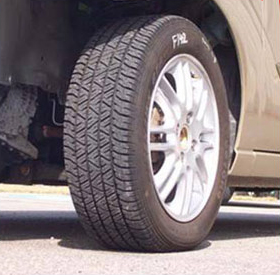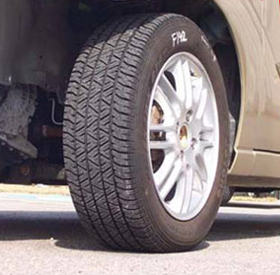Tire Pressure Monitoring Systems
What is a Tire Pressure Monitoring System? Bartec have designed and manufactured hand tool solutions for TPMS since 1998. Beginning with automotive plants in the US, Canada and Europe. We have completed TPMS service tools for Suzuki, GM Holden, Volvo, Ford, Mercedes Benz, Mazda, and recently BMW Motorcycles to name a few. These tools are used by the OE dealers. For advice on which tool is best suited to your needs call our after sales help desk by calling toll free 855-877-9732.
What is a Tire Pressure Monitoring System?
A tire pressure monitoring system or TPMS is an electronic system for monitoring the air pressure in a vehicle tire and automatically transmitting a warning to the driver in the event of an under and, in some cases, over inflated tire. These systems have been legislated to be progressively installed on all new passenger carrying US vehicles and a similar move is taking place worldwide.
The majority of systems use Direct tire sensors which transmit real time tire pressure information to the driver of the vehicle either via a dashboard display or a warning light referred to as the tread light. The sensors are physical pressure transducers which are attached to the back of the valve stem or are in a form which is banded to the wheel. The sensors are manufactured by International companies such as Schrader, Siemens VDO (now VDO Automotive AG), TRW, Pacific Industrial, Lear and others.
There is no common technical standard for the sensors and the OE's and suppliers have generated a multitude of sensor designs. A basic overview of Tire Pressure Monitoring Systems can be found on our dedicated website with an overview of Tire Pressure Monitoring Systems.
The Tire Pressure Monitoring System sensors also transmit data such as their unique sensor ID, temperature, pressure, battery life (where applicable) and other diagnostic information. This data is sent to the Engine Control Unit (ECU) or specific receiver on the vehicle. Those vehicles which have graphical displays of the sensor positions can then show on which wheel there is a problem.
Why is there a need for a Tire Pressure Monitoring System?
Tire Pressure Monitoring helps drivers to properly maintain their vehicle tires, improves vehicle safety and aid fuel efficiency. The National Highway Traffic Safety Administration (NHTSA) in the US has estimated that 533 fatalities per annum are caused by tire defects in road accidents. Adding TPMS to all vehicles could avoid 120 of the 533 yearly victims and save as many as 8,400 injuries every year. Sécurité Routière (the French Institution for Road Safety) estimates that 9% of all fatal road accidents are attributable to tire under-inflation and the German DEKRA estimated that 41% of accidents with physical injuries are linked to tire problems.
Tires leak air naturally and over a year a typical new tire can lose between 3 and 9 psi. As most drivers only check their tires at service intervals and when problems occur there is significant scope for fuel savings and efficiencies using a Tire Pressure Monitoring System.
Given this background the US Federal government has legislated for the mandatory use of a Tire Pressure Monitoring System. The TPMS mandated by the US law must warn the driver when a tire is under-inflated by as much as 25%.
The facts are that underinflated tires are not just a huge safety issue. The other major benefits of properly inflated tires include better fuel economy, longer tire life and better stopping performance. The reality is that properly inflated tires monitored by a properly running Tire Pressure Monitoring System will save the consumer money.
Since it is believed that the TPMS (including the sensors) may last as long or longer than three sets of tires, then the value to maintaining them is high and will save the consumer considerable operating cost over the life of the vehicle.
This is where Bartec comes in. With their complete array of TPMS service tools, the independent service center, chain repair center, Tire Retailer and Service center alike can properly maintain their customer's Tire Pressure Monitoring System. This is the opportunity side of TPMS. Service technicians who can 'TURN THE TREAD LIGHT OFF' and send their customers away satisfied will quickly emerge as the leaders and reap the benefits the TPMS opportunity offers.

70% Inflated

100% Inflated
So when one of your vehicle tires falls below 25% of placard value, the warning light will be displayed on your instrument panel, letting you know to take action. This is a valuable feature in that in most cases you cannot visually detect the difference between a fully inflated tire and one that is only 75% inflated.
What is a tire pressure monitoring tool?
There is no common standard for the Tire Pressure Monitoring System sensors with variations including frequencies, modulations, data structure, communications protocols, mechanical fitment and many other factors.
When a Tire Pressure Monitoring System is installed and tested in the car plant by Bartec the process includes:
- The TPMS sensors are attached to the wheel during the Wheel and Tire assembly process
- The wheels are attached to the vehicle. This is the first time at which the TPMS can be clearly associated with the vehicle
- Fixed radio antennas are used to extract the unique IDs (and other data) of the TPMS, associate them with their wheel position on the car and the Engine Control Unit (ECU) can then be programmed with this data
- The car is then run through Rolls Test where the system is tested.
Similarly the car dealer needs to have a portable Tire Pressure Monitoring System tool available to read the wheel sensor ID and program the car's ECU. This is required in the event of sensor replacement due to mechanical, electronic or battery failure or replacement of wheels and sensors for custom wheels, winter tires, tire rotation etc. He also needs to be able to turn off the TPMS warning light on the dash.
A good TPMS dealer tool should have the following features
1 - The ability to audit the vehicle before the wheel is broken down
This entails using the tool to activate and read back the data from each Tire Pressure Monitoring System sensor. The tool needs to know all of the different low frequency wakeup patterns to transmit to activate the sensors on each type of make/model/year combination. It will need a vehicle look up table for all of these combinations. The tool needs to establish whether each sensor is working or not. This is an important first step because the legislation dictates that the moment the wheel is broken down the responsibility for fixing the problem passes to the dealer. Many dealers have found that customers will not accept the costs for repair and may attribute any breakage to the dealer if there is no audit trail. The Bartec tools offer the capability to show the customer the audit results from the screen or to download them to a PC and print this pre-audit so that a cost can be agreed and the go ahead given before work commences. The tool should decode the signal and be able to vary its activation power level according to the Tire Pressure Monitoring System fitted. To do this it will need to know all of the decode algorithms for all of the different sensors on the market. This is very important in order to avoid picking up the transmission of other Tire Pressure Monitoring System sensors, key fobs etc. It is important to limit your liability for any problems which occur.
2 - Diagnose faults
The Tire Pressure Monitoring System tool should be able to decode the transmission from the sensor and display the data. This will enable the technician to establish if the sensor has failed or is not fitted, whether the pressure port on the sensor is blocked, where the part is running at too high a temperature and other diagnostic information which might be included in the specific sensor (e.g. if there is a low battery condition on the TPMS).
3 - Support the replacement of TPMS sensors and the reprogramming of the car
If a sensor proves faulty or is damaged then it will need to be replaced. This requires a new sensor to be fitted and the ECU to be reprogrammed with its unique ID and its position on the vehicle. The procedures for all vehicles are illustrated in the Bartec Support Login which shows service requirements, reset procedures, dismounting/mounting instructions, torque specifications etc for all makes/models and years.
Most vehicles manufactured in North America have an in-vehicle relearn mode which enables the vehicle to relearn the Tire Pressure Monitoring System ID's when the tool is used to activate the sensor. Not all vehicles may be placed into a re-learn mode (most Asian and European vehicles do not have this feature) and for these the TPMS tool must have an extra interface to the vehicle OBDII/CANbus to communicate with the vehicle Engine Management or Control Unit (ECU or EMU) and download the TPMS data. The Wheelrite TECH400SD has this feature.
- The tool needs to be able to turn off the TPMS warning light
- The tool should ideally display the Service kit number and the replacement part number for the TPMS sensor to ensure the correct part is fitted
4 - Software updateable
New Tire Pressure Monitoring System variants are emerging at an ever faster pace. It is vital that the tool can be updated using a USB cable or similar via a PC with latest TPM variants and all other attributes required to continue servicing new models. Bartec gets this information long before other competitors and so users of our tools always have the most up-to-date software.
Why is Bartec USA the leading authority on TPMS?
Since it installed the first plant system in 1999 Bartec have installed Tire Pressure Monitoring Systems in over 70 plants worldwide and have developed a strong relationship with OE's and sensor manufacturers, whilst remaining an independent party. This enables the company's products to be more up-to-date than any other tool manufacturer. Manufacturers are changing sensor suppliers, specifications and where fitted on a regular basis but Bartec gets to hear about it first. The company has worked in the Wheel and Tire companies, the car plants and with the aftermarket so understands the full range of requirements and many of the features of individual makes and models. Most of all we understand the technology. Our technical help desk is there for the users of our tools to get advice on a daily basis. No other supplier offers such vital and quality resource in this area. The company offers regular training courses on TPMS tools and has training materials available for you to purchase when you are setting out on the Tire Pressure Monitoring System road.
What hand tool experience does Bartec USA have?
We have designed and manufactured hand tool solutions for TPMS since 1998. Beginning with automotive plants in the US, Canada and Europe. We have completed TPMS service tools for Suzuki, GM Holden, Volvo, Ford, Mazda, Mercedes Benz and recently BMW Motorcycles. These tools are used by the OE dealers.
How do TPMS service tools work?
The majority of today's sensors can be activated or woken by sending a 125 kHz LF signal (either continuous wave or modulated). This signal forces the sensor to transmit a coded message at either 315 MHz or 433.92 MHz. The dealer tool will decode that message and provide the CORRECT FEEDBACK to the technician. An effective tool will have in it all the necessary protocols to be effective on all of these types of sensors.
Why is controlling of LF critical?
Some sensors used today are very sensitive to the LF signal transmitted by service tools. Others require a lot of LF to make them transmit. The effective tool is designed with both in mind. Only a company that works with the technology can design software to work on both types. Too much LF used on sensor types that are sensitive and you will likely "wake up" the wrong sensor and ultimately get the wrong 'ID''. Not enough LF for another sensor may mean that you don't wake the sensor at all.
What is RF Decoding?
The RF signal transmitted from the Sensor carries data. Proper decoding of that data by the dealer tool means accurate information for the technician. Tire Pressure Monitoring System tools that do not decode this data can give bad information to the service technician, which is very costly.
Why is decoding important?
Technicians need to be able to trust the tool to provide accurate feedback from the sensor. A tool that does not decode properly can give false or unreliable information. It is important to invest in a tool that accurately decodes the sensor data - this saves time and money!
Where are TPMS service tools required?
TPMS tools are required in OE dealerships, Service Centers and Retail Tire Centers. Multi-brand dealers will benefit greatly from a tool that wakes and decodes the majority of TPMS sensors.
Why are TPMS service tools required?
First and foremost they limit the liability of the repair center. It gives the operator and the customer the confidence that the state of the Tire Pressure Monitoring System is known prior to working on the vehicle. It also provides an opportunity to create a sale in the event that a faulty Tire Pressure Monitoring System sensor is discovered. If a TPMS sensor is replaced, the vehicle must be reset' or "programmed" for the new sensor. If a 'position dependant' vehicle has had a tire rotation, the sensor ID must be re-learned or re-positioned in the car's computer. The need for Tire Pressure Monitoring System tools is financially driven. You can limit cost with a solid TPMS tool, and you can use it to increase services to your customer.
Why purchase a Bartec TPMS Tool
The Bartec Tire Pressure Monitoring System tools properly decode so we can reliably distinguish between TPMS and other RF sources (e.g. key fobs). In other words, you can trust the tools! Upgrading the tool is simple via the USB port. The TECH400 Plus can output sensor data via the same USB using the "AUDIT MODE". The TECH400 Plus has behind it nearly 10 years of Tire Pressure Monitoring System experience and "in-plant" know-how. Bartec has installed Tire Pressure Monitoring Systems on a global basis, and we have brought that expertise to the Automotive Aftermarket.
What kind of information is available on the website?
If it is Tire Pressure Monitoring System related the Bartec team will do their very best to have it on the web site. Our aim is to make the web site a "one stop shop" for TPMS information. TPMS news, technical bulletins, service and work instructions and re-set procedures are all planned for the web site. This will also be the portal for all upgrades and other key downloads.
Please browse our website for more information about Bartec USA LLC and our range of TPMS Tools and our professional Tire Pressure Monitoring System support, then call toll free 855-877-9732 and speak to one of our team or e-mail us at sales@bartecusa.com.
 Bartec USA LLC
Bartec USA LLC